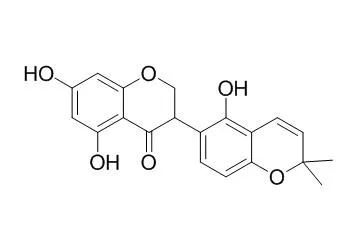| Structure Identification: |
| Molecules. 2009 Oct 9;14(10):3942-51. | | Separation, characterization and dose-effect relationship of the PPARgamma-activating bio-active constituents in the Chinese herb formulation 'San-Ao decoction'.[Pubmed: 19924040 ] | San-ao decoction (SAD), comprising Herba Ephedrae, Radix et Rhizoma Glycyrrhizae and Seneb Armeniacae Amarum, is one of the most popular traditional Chinese medicine (TCM) formulae for asthma. Peroxisome proliferator-activated receptors (PPARs) areey regulators of lipid and glucose metabolism and have become important therapeutic targets for various deseases, PPARgamma activation might exhibit anti-inflammatory properties in different chronic inflammatory processes.
METHODS AND RESULTS:
The EtOAc fraction of SAD showed a significant effect on PPARgamma activation. A simple and rapid method has been established for separation and characterization of the main compounds in the PPARgamma-activating fraction of SAD by ultra-fast HPLC coupled with quadropole time-of-flight mass pectrometry (UPLC-Q-TOF/MS). A total of 10 compounds were identified in the activating fraction of SAD, including amygdalin (1), liquiritin (2), 6'-acetyliquiritin (3), liquiritigenin (4), isoliquiritigenin (5), formononetin (6), Licoisoflavanone (7), glycycoumarin (8), glycyrol (9) and uercetin (10). The results also characterized formononetin as a predominant component in this fraction.
CONCLUSIONS:
The dose-effect relationship comparison study of formononetin and the EtOAc fraction of SAD by adding formononetin was performed, the results suggested that formononetin was the major component of the EtOAc fraction of SAD responsible for activating PPARgamma, and the method will possibly be applied to study the complex biological active constituents of other TCMs. |
|






 Cell. 2018 Jan 11;172(1-2):249-261.e12. doi: 10.1016/j.cell.2017.12.019.IF=36.216(2019)
Cell. 2018 Jan 11;172(1-2):249-261.e12. doi: 10.1016/j.cell.2017.12.019.IF=36.216(2019) Cell Metab. 2020 Mar 3;31(3):534-548.e5. doi: 10.1016/j.cmet.2020.01.002.IF=22.415(2019)
Cell Metab. 2020 Mar 3;31(3):534-548.e5. doi: 10.1016/j.cmet.2020.01.002.IF=22.415(2019) Mol Cell. 2017 Nov 16;68(4):673-685.e6. doi: 10.1016/j.molcel.2017.10.022.IF=14.548(2019)
Mol Cell. 2017 Nov 16;68(4):673-685.e6. doi: 10.1016/j.molcel.2017.10.022.IF=14.548(2019)